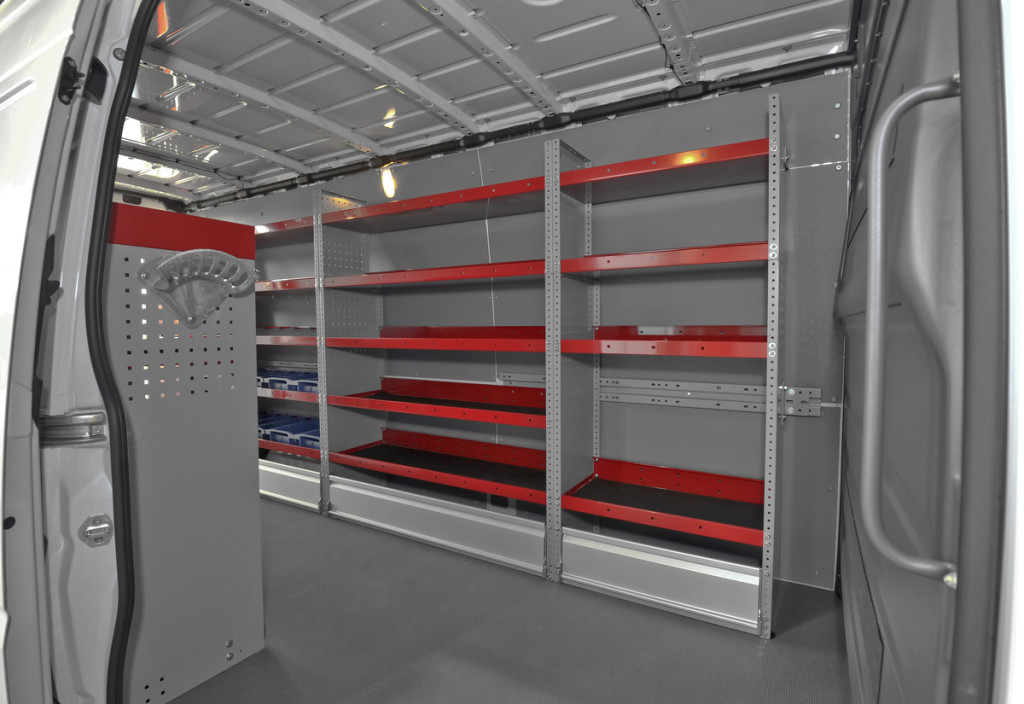Ride On
 When it comes to purchasing a new commercial vehicle, it’s never been a one-size-fits-all situation for professional painting contractors. From the area of the country you work in, to your paint and gear demands, to the overall cost of ownership, the factors that go into making a decision are as individual as your business. The good news is, today’s variety of vans and trucks offer hundreds of different base configurations—plus countless add-ons through upfitters.
When it comes to purchasing a new commercial vehicle, it’s never been a one-size-fits-all situation for professional painting contractors. From the area of the country you work in, to your paint and gear demands, to the overall cost of ownership, the factors that go into making a decision are as individual as your business. The good news is, today’s variety of vans and trucks offer hundreds of different base configurations—plus countless add-ons through upfitters.
The current trend throughout the trades is the surge of European-style vans. “It used to be that larger vans from Dodge, Chevy, Ford, and everyone else were all pretty similar—you were just picking the brand,” says Dave Sowers, Chrysler’s head of Ram Commercial Marketing. “They were little more than a pickup with a different body. Everything was a front engine with rear-wheel drive, and inefficient on every level—getting in and out, cargo-carrying capacity, and cost of ownership.”
HIGHLY CONFIGURABLE CHOICES IN TOP BRANDS
Today, that couldn’t be more different. Depending on the make and model, configurations will include an array of gas or diesel engine choices, power trains, payload and towing ratings, doors, and height and wheelbase-length choices. Here’s a quick look at a few of the vans that experts say make the most sense for today’s painting contractors:
Ram’s full-size ProMaster and Class 1 ProMaster City vans have their roots in the company’s corporate relationship with Fiat in Europe, and exemplify the manufacturer’s focus on commercial vehicles that started four years ago. “They’re unibody products, which is a change from the old body-on-frame that vans used to be,” Sowers says. “We’ve changed the powertrain to make sure it’s durable for U.S. conditions. If you had a clean slate, they are what you’d design.”
Ford Class 1 Transit Connect and full-size Transit vans display a similar European sensibility. “The most popular version for contractors in general has been the medium-roof, long-wheelbase Transit,” says Yaroslav Hetman, brand manager for the Ford Transit/Transi
Connect/E-Series. “Specifically, it allows the contractor to have a mobile workshop. If you’re six feet tall, you can stand up straight in the back, you can fit all of your tools and equipment and, at the same time, you don’t have to worry about the security or weather disadvantages of a pickup truck.” For 2016, Ford added dual sliding doors, allowing convenient access to the vehicles from either side, and fleet options like speed limitation to 70 mph.
Mercedes-Benz’s one-two punch in the van world includes the Sprinter, which has been updated for 2016 with standard window air bags and thorax air bags. And the Metris Cargo Van, which enters its first full year of availability in 2016, launched in the U.S. in late 2015. All Sprinters sold in the U.S. are powered by BlueTec clean diesel engines, although a V6 turbocharged diesel is available as an option for more power—and can also be had in a 4×4 power train.
Chevrolet Express Cargo Van and Chevrolet City Express van, as well as the GMC Savana Cargo van, are the comparable offerings from General Motors, which this year is touting the addition of an OnStar 4G LTE Wi-Fi Hotspot for ease of communications.
Like the Sprinter, the changes to the Nissan NV Cargo van for 2016 include supplemental front-seat-mounted side-impact air bags and roof-mounted curtain side-impact air bags for front outboard occupant head protection, added as standard equipment. Its NV200 Compact Cargo van sibling may look tiny, but its cargo area allows for loading standard 40″x48″ pallets.
COMPARING THE NEW GENERATION OF VANS
You’ll need to consult individual automakers for the specific packages they offer, but the options—and advantages—can be fairly generalized. As with any vehicle purchase, it comes down to trade offs and deciding how important the options are for you.
• Different interior and exterior heights. Inside the smaller, low-roof vans, you’re obviously not going to be able to stand up straight, yet they offer a benefit for contractors who do a lot of work in cities and need to squeeze into underground garages and into tight parking spaces. A medium roof might accommodate someone who’s six feet tall, while the highest specs can allow someone a few inches taller to walk the length of the cargo bay without hitting their head. Don’t just look up, though: Consider the height of the load floor from the ground. “When you’re constantly lifting 5-gallon buckets of paint, drywall compound, or a paint compressor in and out of the van, a low step-in height makes a difference,” says Sowers.
• Different lengths. In addition to increasing the overall cubic cargo space, a longer vehicle offers the advantage of being able to carry ladders inside. “When you put a ladder on top of a vehicle, it decreases your fuel economy as much as 30%,” says Ford’s Hetman. “When you do the math, if you’re driving 100,000 miles a year, that’s a lot of money you’re spending on fuel just to have the ladder up there—not to mention the added theft risk.” In the long wheelbase version of the Transit, you can fit a 12′ ladder, while the high-roof, extended-length version will accommodate one that’s 14′ long from the driver’s seat to the back door.
• Performance. Sowers notes that front-wheel drive is better for traction, particularly in inclement weather in the northern U.S. “It also gives you a better turning radius, which makes it easier to get in and out of customer driveways or loading docks,” he says. “One of the side benefits of these vans, in an age where it’s tough to get qualified employees, is that you don’t need a special license. You can focus on employees with the painting skills you want, and not worry as much about the safety aspect related to vehicles without current technology.” Features like electronic stability control, back-up sensors and back-up cameras keep people from backing into things—which also minimizes downtime.”
• Service and maintenance. One of the most important aspects of a commercial vehicle is preventing time at the mechanic shop. If the vehicle isn’t running, it’s costing you money. So, consider where the nearest dealership is when it comes time for regular maintenance, or where you might need to have emergency work done in the event of a breakdown. Many dealers promote priority service for commercial customers, which means you get the first available bay.
• Overall cost of operation. It’s easy to focus on fuel economy figures—and the vehicles listed above offer good or outstanding mileage. For painters focused on efficiency, some of the smaller vans get up to 29 mpg on the highway, which is impressive for a cargo vehicle. But the real number you need to look at when considering a purchase is the overall cost of operation over the long term: initial costs, taxes, fees, fuel, maintenance, repair, insurance and depreciation.
HOW TO SORT THROUGH YOUR CHOICES
Your vehicle selection process will most likely begin with a look at manufacturers’ web sites, which offer a wide range of ways to configure the base vehicle. Their goal, of course, is to make it easy and cost-effective for a tradesman to build the perfect vehicle for their business. Engines alone can make for challenging choices: In the Ford Transit, for example, the base engine is a 3.7-liter 6-cylinder with 275 HP and 260 foot-pounds of torque, while the 3.5-liter EcoBoost 6-cylinder offers 400 foot-pounds of torque for more towing power or carrying heavy payloads. At the high end, the 3.2-liter Power Stroke diesel enables towing as much as 7,500 pounds, and is also Ford’s best choice for long idle times and high mileage.
With so many choices, the process can seem daunting, which is why Ram’s Sowers recommends consulting with a local dealer to help you decide the specifications that best meet your needs. “Dealers are the experts on the vehicle options, and also have relationships with the local upfitters,” he says. “A dealer can go through the offerings from different suppliers with you, such as shelving or ladder racks, and have it installed before or after you take delivery.” He emphasizes the importance of working with a certified upfitter in order to get everything installed properly. When van shopping, he also suggests you research possible dealer incentives—and not just on the purchase price or financing. Ram, for example, offers up to $1,000 for upfitting on the ProMaster and $500 on the ProMaster City.
There’s no question that Americans have an emotional attachment to pickup trucks, which outsold vans by about 4 to 1 in 2015. When you consider the across-the-board financial and practical advantages vans can offer, however, the market share balance may tip the other way in the coming years.
“Pickups can be good solutions if you encounter particular needs such as rough roads or 4×4 capability,” says Hetman. “But as you look at those vehicles, they’re typically more expensive in terms of total cost of ownership. As with painting or any of the trades, it’s about finding the right tool for the job at the right cost.”




